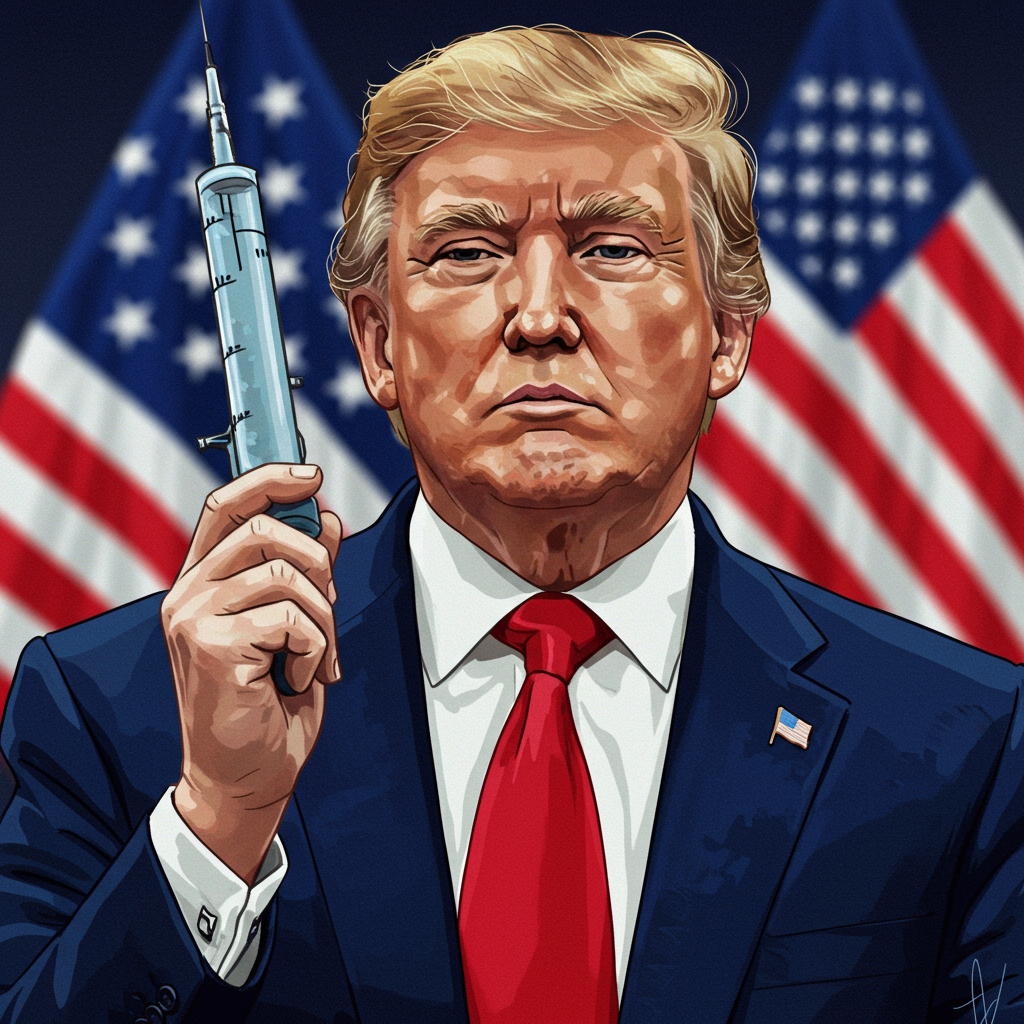A significant public health debate has erupted concerning the measles, mumps, and rubella (MMR) vaccine, driven by high-level calls to dismantle its highly effective, decades-old combined format. Acting CDC Director Jim O’Neill and President Donald Trump have advocated for replacing the standard MMR shot with three individual, or “monovalent,” vaccines. This push, made without supporting scientific evidence, has ignited strong criticism from medical experts and public health organizations who warn of severe consequences for childhood immunization and disease prevention in the United States.
The Controversial Call for MMR Vaccine Separation
On October 6, 2025, Acting CDC Director Jim O’Neill publicly urged vaccine manufacturers to develop separate shots for measles, mumps, and rubella. This recommendation, articulated in a post on X (formerly Twitter), directly referenced President Donald Trump’s earlier advice on Truth Social to “break up the MMR shot into three totally separate shots.” O’Neill, who also serves as Deputy Health Secretary, praised Trump’s suggestion, signaling a broader administration focus on re-evaluating established vaccine policies.
This call for “safe monovalent vaccines” emerges amidst a concerning rise in measles cases across the U.S., with 2025 recording more infections than any year since the disease was declared eliminated in 2000. Experts, including infectious disease physician Jake Scott of Stanford University, emphasize that current outbreaks are primarily due to a lack of vaccination, not any issue with the existing combined vaccine.
Why Experts Oppose Splitting the MMR Vaccine
The proposal to separate the MMR vaccine faces overwhelming opposition from the scientific and medical community. There is a fundamental lack of published scientific evidence demonstrating any benefit, either in terms of safety or effectiveness, to administering separate shots for measles, mumps, and rubella compared to the combined vaccine.
No Scientific Rationale: O’Neill’s and Trump’s statements provided no supporting medical research, safety concerns, or data to justify breaking up the combined vaccine. This absence of scientific basis is a primary point of contention for public health professionals.
Logistical Impossibility (Currently): Crucially, monovalent vaccines for measles, mumps, or rubella are not currently approved or available in the U.S. Developing new single-virus shots would be a monumental undertaking, requiring years of research and development, extensive clinical trials, and a rigorous Food and Drug Administration (FDA) approval process. William Moss, director of the International Vaccine Access Center at Johns Hopkins University, characterized O’Neill’s call as an unscientific approach to policy-making, highlighting the unlikelihood of ethical boards approving trials for diseases with already effective vaccines.
Increased Injections & Reduced Compliance: The MMR vaccine has been available as a combination shot since 1971, precisely to reduce the number of injections children receive. The standard two-dose MMR regimen, recommended at 12-15 months and 4-6 years, means two shots. Separating these would result in six injections for children, dramatically increasing the number of doctor visits. Historically, more injections lead to lower vaccination completion rates, leaving children vulnerable to preventable diseases. Merck, the manufacturer of the MMR vaccine, warns that individual vaccines “increase the number of injections for the individual and may result in delayed or missed immunizations.”
Improved Childhood Vaccination Outcomes: In contrast to the unsupported claims for separation, Merck explicitly states that “evidence suggests that use of combination vaccines improves childhood vaccination outcomes, increasing both completion (receipt of all recommended doses) and compliance (age-appropriate administration) rates.” Dr. Rana Alissa, president of the Florida chapter of the American Academy of Pediatrics, notes that combining the shots not only reduces visits but also leads to a “much better” immune response, fostering lifelong immunity.
The Discredited Origins of Separation Claims
The idea of separating the MMR vaccine components has a notorious history, originating from Andrew Wakefield’s discredited 1998 paper. This paper falsely claimed a link between the MMR vaccine and autism, a claim that has been unequivocally disproven by numerous robust studies. Wakefield’s paper was retracted, and he was removed from the U.K.’s medical register. Experts emphasize that there is no credible evidence connecting the MMR vaccine to autism, nor any advantage to separating its components in terms of safety or effectiveness.
Amish Adalja, an infectious disease expert at the Johns Hopkins Center for Health Security, voiced concern that such proposals “falsely imply that there is something unsafe” about combined vaccines, describing it as “another example of the federal government pandering to the anti-vaccine movement.”
Differentiating MMR from MMRV: A Crucial Distinction
It’s important to distinguish the debate over the standard MMR vaccine from recent policy changes regarding the MMRV vaccine, which combines measles, mumps, rubella, and varicella (chickenpox). Unlike the call to separate MMR, the Department of Health and Human Services has implemented a policy change regarding the MMRV shot for younger children.
On September 18, the CDC’s vaccine advisory committee, with O’Neill’s subsequent approval, recommended against using the MMRV vaccine for children under four. This decision was based on a known, scientifically validated increased risk of febrile seizures (seizures prompted by fevers) in younger children when given the MMRV shot, a risk that medical professionals had been aware of for years. Most pediatricians already administer the MMR and chickenpox vaccines separately to young children. The MMRV vaccine remains an option for older children where this specific risk is not observed. President Trump expressed satisfaction with this specific evidence-based decision to separate the chickenpox vaccine from MMR. This distinction highlights that scientifically-backed vaccine policy changes do occur, contrasting sharply with the unsupported push to separate the MMR vaccine.
Broader Context: Political Influence and Public Health Risks
The discussion around the MMR vaccine unfolds against a backdrop of significant shifts in U.S. vaccine policy. Health Secretary Robert F. Kennedy Jr., known for founding an anti-vaccine group and making false claims about vaccine safety, has reportedly replaced the national vaccine advisory board with members largely sharing his views. This new committee is actively reviewing the childhood vaccine schedule. While Kennedy Jr. has also stated people should get vaccinated, his past rhetoric and current influence raise concerns among medical professionals.
Moreover, the CDC has revised its COVID-19 vaccine recommendations, moving from a universal endorsement to a “shared decision-making” model with healthcare providers. This change, while aimed at ensuring insurance coverage, requires individuals to consult a professional about risks and benefits before vaccination. Many independent vaccine experts, like Dorit Reiss from the University of California, San Francisco, argue this misrepresents previous policy and could create unnecessary hurdles, potentially reducing vaccine uptake.
The Threat to Public Health
Medical professionals express deep concern that unsupported rhetoric from high-ranking officials about established vaccines could significantly deter parents from vaccinating their children. Jake Scott warned that the “totally predictable” outcome of such statements is lower vaccination rates, an increase in preventable diseases, and more childhood deaths.
The MMR vaccine has been safely and effectively administered for over half a century to millions, demonstrating its efficacy in preventing measles, mumps, and rubella with minimal risks. The primary documented side effect is a small increased risk of a febrile seizure within 12 days of vaccination, estimated at one additional seizure per 3,000-4,000 vaccinations – a minor and temporary risk far outweighed by the dangers of these diseases.
Frequently Asked Questions
What is the current scientific stance on separating the MMR vaccine?
The overwhelming scientific and medical consensus is that there is no published evidence demonstrating any benefit to separating the measles, mumps, and rubella (MMR) vaccine into individual shots. Major health organizations like the CDC and leading medical experts actively oppose this proposal, emphasizing that the combined vaccine is safe, effective, and crucial for public health. Calls for separation are currently not supported by medical research or data.
Are monovalent measles, mumps, or rubella vaccines currently available in the U.S.?
No, monovalent (single-virus) vaccines for measles, mumps, or rubella are not currently approved or available for use in the U.S. Developing and approving new individual vaccines would be a years-long process, requiring extensive research, clinical trials, and FDA approval. The existing combined MMR vaccine has been the standard of care since 1971.
How does separating the MMR vaccine impact childhood immunization schedules and disease prevention?
Separating the MMR vaccine would drastically increase the number of injections children receive, from two doses of the combined shot to six individual shots. This increase in visits and injections historically leads to lower vaccination completion rates, leaving children more vulnerable to measles, mumps, and rubella. Medical experts warn that such a change could undermine decades of progress in disease prevention and potentially lead to resurgences of these infectious diseases.
Conclusion
The call to separate the MMR vaccine into individual shots represents a significant challenge to established public health practices. While high-ranking officials like Acting CDC Director Jim O’Neill and President Donald Trump advocate for this change, their position lacks any backing from scientific evidence or medical consensus. Experts widely warn that such a move would be logistically unfeasible, increase the burden on children and parents, and critically endanger public health by lowering vaccination rates and increasing the risk of preventable diseases. As measles cases rise across the U.S., adhering to evidence-based immunization schedules and trusting the robust safety and efficacy data behind combination vaccines remains paramount for protecting community health.



